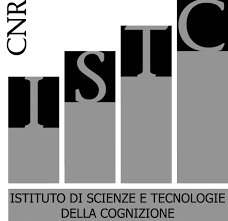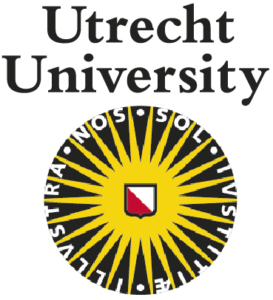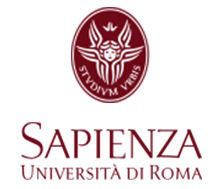National Research Council
 The National Research Council (CNR) is the largest public research institution in Italy. The Institute of Cognitive Sciences and Technologies (ISTC) is one of more than 100 institutes belonging to the CNR, and is the department carrying out the project. The main field of interest of the ISTC is the Cognitive Science, as the general study of the Intelligent Systems: natural and artificial, human and non-human, individual and collective; the underlying architectures and the involved cognitive processes; the development and the evolution of such processes, including the pathologic ones and the resulting behavioural disorders. The ISTC presents an approach that is inter-disciplinary: the researchers come from different domains such as Psychology, Philosophy, Linguistics, Primatology, Sociology, Robotics, Informatics, Neuroscience and Artificial Intelligence. The Institute carries out its research mission through the concurrent activities of several laboratories and research groups which collaborate in order to increase the knowledge in the domain of the Cognitive Science.
The National Research Council (CNR) is the largest public research institution in Italy. The Institute of Cognitive Sciences and Technologies (ISTC) is one of more than 100 institutes belonging to the CNR, and is the department carrying out the project. The main field of interest of the ISTC is the Cognitive Science, as the general study of the Intelligent Systems: natural and artificial, human and non-human, individual and collective; the underlying architectures and the involved cognitive processes; the development and the evolution of such processes, including the pathologic ones and the resulting behavioural disorders. The ISTC presents an approach that is inter-disciplinary: the researchers come from different domains such as Psychology, Philosophy, Linguistics, Primatology, Sociology, Robotics, Informatics, Neuroscience and Artificial Intelligence. The Institute carries out its research mission through the concurrent activities of several laboratories and research groups which collaborate in order to increase the knowledge in the domain of the Cognitive Science.
People from ISTC-CNR are described here.
Utrecht University
 Established in 1636, Utrecht University (UU) has evolved into a leading modern, comprehensive research university with a growing international reputation. On the 2017 Shanghai Academic Ranking of World Universities, Utrecht University ranks first in the Netherlands, 14th in Europe and 51st in the world. UU has an annual turnover of over 800 million euro, around 30% of which from external funding. The UU department of Information and Computing Sciences (ICS) includes three divisions: Interaction, Algorithms, and Intelligent Software Systems, with research ranging from algorithmic foundations to applied human-centered computing, often in medical and health settings. The division interaction develops and analyses technology-mediated communication and interaction between people and communication and interaction between systems and people. The interaction technologies make use of various modalities, in particular visual, auditory, and haptic modes, while taking into account people's cognitive and affective states.
Established in 1636, Utrecht University (UU) has evolved into a leading modern, comprehensive research university with a growing international reputation. On the 2017 Shanghai Academic Ranking of World Universities, Utrecht University ranks first in the Netherlands, 14th in Europe and 51st in the world. UU has an annual turnover of over 800 million euro, around 30% of which from external funding. The UU department of Information and Computing Sciences (ICS) includes three divisions: Interaction, Algorithms, and Intelligent Software Systems, with research ranging from algorithmic foundations to applied human-centered computing, often in medical and health settings. The division interaction develops and analyses technology-mediated communication and interaction between people and communication and interaction between systems and people. The interaction technologies make use of various modalities, in particular visual, auditory, and haptic modes, while taking into account people's cognitive and affective states.
People from UU are described here.
Center for Research and Interdisciplinarity
 The Center for Research and Interdisciplinarity (CRI) experiments and spreads new ways of learning, teaching, conducting research and mobilizing collective intelligence in life, learning and digital sciences. Research at CRI is a collaboratory at the crossroads of life, learning, and digital sciences, affiliated to University of Paris. Founded in the spirit of facilitating the transition from closed scientific enquiry to a more open model, the CRI aims to transcending barriers between disciplines, science and society. The CRI fosters research at crossroads between interdisciplinary life and health sciences, basic understanding of learning processes and novel education technology/methodology testing and implementation, and digital sciences. The CRI pursuse open, collaborative research projects to tackle the world’s health and education challenges, focusing on the following broad topics, amenable to bridge foundational research and societal impact:
The Center for Research and Interdisciplinarity (CRI) experiments and spreads new ways of learning, teaching, conducting research and mobilizing collective intelligence in life, learning and digital sciences. Research at CRI is a collaboratory at the crossroads of life, learning, and digital sciences, affiliated to University of Paris. Founded in the spirit of facilitating the transition from closed scientific enquiry to a more open model, the CRI aims to transcending barriers between disciplines, science and society. The CRI fosters research at crossroads between interdisciplinary life and health sciences, basic understanding of learning processes and novel education technology/methodology testing and implementation, and digital sciences. The CRI pursuse open, collaborative research projects to tackle the world’s health and education challenges, focusing on the following broad topics, amenable to bridge foundational research and societal impact:
- Open health: from data-rich research to development of frugal software and hardware solutions
- Open learning: from understanding learning to human-machine paradigms
- Open AI: understanding and shaping current digital transition in context of learning, health and/or human-machine paradigms.
The research team involved in this project is affiliated to the BabyLab of the INCC (Integrative Neurosciences and Cognition Centre) University of Paris, which welcomed 1700 babies in 2018. This team has expertise in developmental psychology and more specifically in sensorimotor development and tool-use acquisition in young children.
People from CRI are described here.
University of Rome Sapienza

The University of Rome Sapienza is one of the largest European universities by enrolments and one of the oldest in history, founded in 1303 by Pope Boniface VIII. Today Sapienza, with 140,000 students and 8,000 among academic and technical and administrative staff, is the largest and prestigious Italian universities in the world, commonly ranking first in national rankings and in Southern Europe. Sapienza has 11 Faculties, 63 Departments and various research centres that drive high levels of excellence in archaeology, physics and astrophysics, as well as humanities and cultural heritage, environmental studies, nano-technology, cellular and gene therapy, design and aerospace.
The Department of Human Neuroscience carries out the project, through the Section of Child and Adolescent Neuropsychiatry. The clinical and scientific activity of the Department is focused on the diagnosis and treatment of neurological and psychiatric diseases of adults and children and also has neurological and psychiatric day hospitals.
The Section of Child and Adolescent Neuropsychiatry is the largest Italian institution dedicated to the study of neurological and psychiatric diseases with an onset in the developmental age. Furthermore, the Institute carries out an important and continuous training activity for all child neuropsychiatry centres in the Lazio region. The clinical activity of the Section is focused on the diagnosis and treatment of neurological and psychiatric diseases of the child. Furthermore, since January 2018, it has been accredited by the Lazio Region as a Clinical Reference Centre for 42 metabolic diseases for neonatal screening. As regards the psychiatric area, it is a clinical and research reference structure for developmental disorders and in particular for Autism Spectrum Disorders (ASD), attention deficit hyperactivity disorder, anxiety disorders and somatization disorders. It conducted some research on early signal and early diagnosis in children with ASD which can significantly improve the quality of life of individuals with ASD as well as of their caregivers and parents.
People from SAPIENZA are described here.
Plux - Wireless Biosignals S.A.

PLUX was created in 2007 with the ambition of helping the world access human biosignals to improve solutions for health, research and, overall, simplify human-computer interaction scenarios. During its journey PLUX has been able to collaborate in innovative research in a growing number of science fields that use biosignals as key data to improve human health, performance or to expand the frontiers of knowledge. PLUX creates innovative products for Healthcare and Research, by developing advanced biosignal monitoring platforms that integrate wearable body sensors such as electromyography, electrocardiography, respiration, accelerometers, and others, combined with wireless connectivity and software applications to deliver real value recognized by our target markets. PLUX has a significant track record in the creation of innovative added-value products, examples of which include the work on novel technologies for physical rehabilitation. An advanced wireless toolkit designed for researchers to collect and analyze reliable, high definition biosignals data, Biosignalsplux. The latest success case is a DYI product, BITalino, which in little over five years gathered more than 4000 users, base scattered across more than 30 countries worldwide.
The company's mission is to create miniaturized sensors and wearable devices for biosignal acquisition and processing. All products aim to provide users with maximum comfort and safety, together with user-friendly software. Given the strong partnerships established with other scientific institutions, PLUX sets the bridge between the academic field and the market, by applying and projecting the research know‑how to problems and practical needs, in several technological areas.
From high know-how on analog-digital filtering and amplification electronics, PLUX can provide the acquired signals with very low noise, high sensitivity and high immunity to electronic interference. Currently the company has a set of biomedical sensors such as, Functional near-infrared spectroscopy sensor (fNIRS), Electroencephalography (EEG), Electrocardiography (ECG), Electromyography (EMG), Electrodermal Activity (EDA), respiration, accelerometer and others, from which several physiological parameters can be extracted, such as: heart rate (HR), heart rate variability (HRV), muscle activation (EMG), sympathetic events from EDA sensors or energy expenditure from an accelerometer. Beyond biomedical sensors, PLUX also has expertise in hardware development, enabling the quick turnaround and discovery of new solutions, new applications, third-party sensors integration and market-focused strategies in the field of biosignal sensing.
People from PLUX are described here.
Quantum Leap IP
(third party involved in the project)

The company Quantum Leap IP is a leading consulting company in Technology Transfer and Open Innovation. It supports research centers, industries and innovative start-ups for the definition of new valorisation paths, aimed at the growth and diffusion of innovation produced on an international scale. Quantum Leap IP will support the consortium for the exploitation activities related to the technological results obtained in the IM-TWIN project.
Importantly, the CEO of Quantum Leap IP is the EU Innovation Officer of the FET EU project GOAL-Robots. The company is hence in the best position to support the exploitation of the technological potential of GOAL-Robots for technological transfer within the IM-TWIN Project.
Quantum Leap will bring to the Consortium a unique expertise on technological transfer, in particular it will support CNR, PLUX and the other partners to accomplish the following tasks:
- Market identification
- Patenting: national, EU, international
- Management of IPR
- Preparation of business plans
- Seeking of funders of the project outcomes, in particular for the newly created startup
People from Quantum Leap IP are described here.
